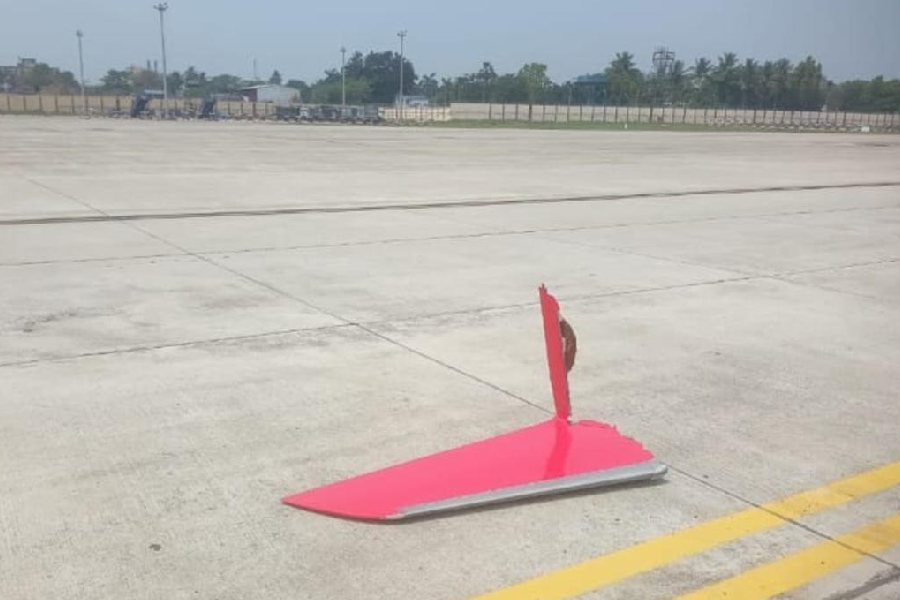The air traffic control (ATC) at the Calcutta airport asked the Air India Express aircraft to stand at the holding point for 19Right. The aircraft allegedly stood at the holding point for 19Left.
Result: the aircraft was allegedly stationed 46 metres behind where it should have been, said sources.
A communication gap, the ATC not following safety protocols and an oversight — the three factors possibly combined on Wednesday morning, leading to a wing of an IndiGo plane that was taxiing for take-off grazing a wing of the stationary Air India Express aircraft.
The IndiGo aircraft (Airbus A320) was to fly to Darbhanga, while the Air India Express plane (Boeing 737Next Generation) was on hold for take-off for Chennai.
The Directorate General of Civil Aviation (DGCA) is conducting a probe into the reasons for the collision.
The tip of the left wing of the Air India Express plane fell on the tarmac and the right wingtip of the IndiGo aircraft got dented. Both aircraft were to take off from the northern end of the runway.
Metro spoke to several officials of the Airports Authority of India (AAI) to find out what could have caused the accident.
Communication gap
The Air India Express aircraft had moved through taxiway N4 and entered taxiway A through a passage connecting the two. It was supposed to enter the secondary runway for take-off because the primary runway was under routine maintenance, said sources.
The aircraft was supposed to halt at the holding point on taxiway A that is designated for planes that take off from the secondary runway.
“There are two holding points on taxiway A — one for the secondary and the other for the primary runway. We use the code ‘19Right’ for the northern end of the secondary runway and ‘19Left’ for the nothern end of the primary runway,” said an airport official.
The northern end of the secondary runway (19Right) has the Category I instrument landing system, while the northern end of the primary runway (19Left) has the more advanced Category II system. “So, the holding point for 19Right has to be closer to the runway compared with the holding point for 19Left, which is behind the other,” the official said.
“The ATC had asked the pilot of the Air India Express aircraft to be at the holding point for 19Right, but probably by mistake, the aircraft stood near the holding point for 19Left, which is 46m behind the spot where it was instructed to halt. That dangerously narrowed the gap between the two aircraft.”
Safety measures
An AAI official said a large portion of taxiway A is now closed for operations. Smaller aircraft that move through taxiway N4 are often allowed to reach the runway for take-off through the operational portion of taxiway A.
“Both taxiways can handle only small aircraft. But, as an additional safety measure, when one aircraft is at a holding point on taxiway A, usually another aircraft is
not allowed through N4,” the official said.
Taxiway N4 merges with taxiway N, which leads to the northern edge of both runways.
“The probe by the DGCA will find out why the IndiGo aircraft was given the clearance to move along N4, behind the Air India Express plane, even though the later was stationary at a holding point on taxiway A,” the official said.
Through taxiway A an aircraft reaches either runway at a point that is 300m from the northern edge, another official said.
“Often pilots of smaller aircraft request for take-off through taxiway A because it saves fuel and time. The aircraft do not have to travel another 300 metres, to the edge of the runway,” he pointed out. “The ATC often allows such requests.”
Possible oversight
There was a possible oversight by the cockpit crew of the IndiGo flight, officials said.
“The pilots, while taxiing, should be alert to the surroundings. Other aircraft and tarmac vehicles move around the operational area. These are supposed to stay in designated lanes, but at times mistakes can happen,” said an official.
“The IndiGo cockpit crew should have taken adequate safety measures when another aircraft was stationary dangerously close. They should have sought help of a ‘Follow-Me’ jeep. Such jeeps are in the tarmac area to guide aircraft in difficult situations,” said the official.






